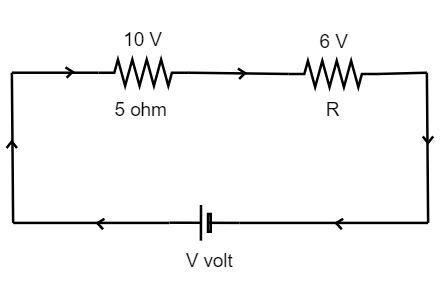
Two resistance connected in series as shown in diagram. What is the value of $R$ ?
(A) $4\,\Omega $
(B) $6\,\Omega $
(C) $5\,\Omega $
(D) $3\,\Omega $
Answer
219k+ views
Hint: use the formula of the ohm’s law and rearrange it. Substitute the known potential difference and the resistance in it to find the current value. Use this current value in the ohm’s law again to find the value of the unknown resistance of the second resistor.
Useful formula:
(1) The formula of the ohm’s law is given by
$V = IR$
Where $V$ is the potential difference, $I$ is the current and $R$ is the resistance.
Complete step by step solution:
From the given diagram, the resistance of the first resistor, ${R_1} = 5\,\Omega $
Potential difference of the first resistor, ${V_1} = 10\,V$
Potential difference of the second resistor, ${V_2} = 6\,V$
The given circuit is the series circuit that consists of the two resistors of the known and the unknown resistors
Using the ohm’s law,
$V = IR$
By rearranging the formula, we get
$I = \dfrac{V}{R}$ ……………………(1)
Substitute the known parameters in the above step, we get
$I = \dfrac{{10}}{5} = 2\,A$
Substitute the condition for the second resistor in the equation (2),
$I = \dfrac{6}{{{R_2}}}$
Since this is a series circuit, the current in the resistor will be the same.
$
2 = \dfrac{6}{{{R_2}}} \\
{R_2} = 3\,\Omega \\
$
Hence the resistance of the second resistor is $3\,\Omega $ .
Thus the option (D) is correct.
Note: Remember that if the resistors are connected in series, the current will be the same through each resistor and its potential difference will be equal to the sum of the potential difference developed in each resistor. If the resistor is connected in parallel, the current will be the sum of the current through each resistor and its potential difference will be the same to each resistor.
Useful formula:
(1) The formula of the ohm’s law is given by
$V = IR$
Where $V$ is the potential difference, $I$ is the current and $R$ is the resistance.
Complete step by step solution:
From the given diagram, the resistance of the first resistor, ${R_1} = 5\,\Omega $
Potential difference of the first resistor, ${V_1} = 10\,V$
Potential difference of the second resistor, ${V_2} = 6\,V$
The given circuit is the series circuit that consists of the two resistors of the known and the unknown resistors
Using the ohm’s law,
$V = IR$
By rearranging the formula, we get
$I = \dfrac{V}{R}$ ……………………(1)
Substitute the known parameters in the above step, we get
$I = \dfrac{{10}}{5} = 2\,A$
Substitute the condition for the second resistor in the equation (2),
$I = \dfrac{6}{{{R_2}}}$
Since this is a series circuit, the current in the resistor will be the same.
$
2 = \dfrac{6}{{{R_2}}} \\
{R_2} = 3\,\Omega \\
$
Hence the resistance of the second resistor is $3\,\Omega $ .
Thus the option (D) is correct.
Note: Remember that if the resistors are connected in series, the current will be the same through each resistor and its potential difference will be equal to the sum of the potential difference developed in each resistor. If the resistor is connected in parallel, the current will be the sum of the current through each resistor and its potential difference will be the same to each resistor.
Recently Updated Pages
A square frame of side 10 cm and a long straight wire class 12 physics JEE_Main

The work done in slowly moving an electron of charge class 12 physics JEE_Main

Two identical charged spheres suspended from a common class 12 physics JEE_Main

According to Bohrs theory the timeaveraged magnetic class 12 physics JEE_Main

ill in the blanks Pure tungsten has A Low resistivity class 12 physics JEE_Main

The value of the resistor RS needed in the DC voltage class 12 physics JEE_Main

Trending doubts
JEE Main 2026: Application Form Open, Exam Dates, Syllabus, Eligibility & Question Papers

Understanding Uniform Acceleration in Physics

Derivation of Equation of Trajectory Explained for Students

Hybridisation in Chemistry – Concept, Types & Applications

Understanding the Angle of Deviation in a Prism

Understanding Collisions: Types and Examples for Students

Other Pages
JEE Advanced Marks vs Ranks 2025: Understanding Category-wise Qualifying Marks and Previous Year Cut-offs

Understanding Atomic Structure for Beginners

How to Convert a Galvanometer into an Ammeter or Voltmeter

Understanding Centrifugal Force in Physics

JEE Main Marking Scheme 2026- Paper-Wise Marks Distribution and Negative Marking Details

Degree of Dissociation: Meaning, Formula, Calculation & Uses




